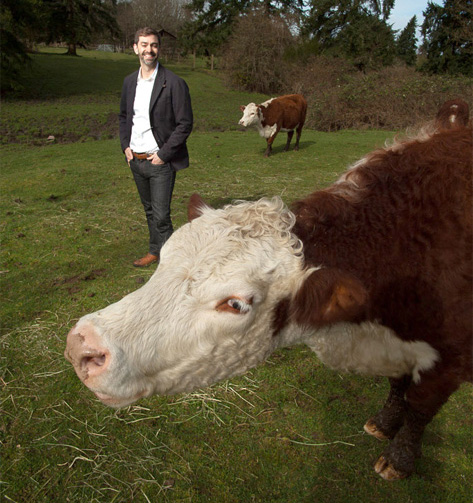Greener Pastures
As interim CEO of Salt of the Earth (SOTE) Ranchers Cooperative—a national cooperative that is gearing up to supply grass-fed beef directly to consumers—Justin Leavenworth ’96 takes it in stride when he meets with a new group of ranchers who don’t know what to make of his skinny jeans and hipster glasses, when they come to the table thinking, “This guy can’t possibly have anything in common with us!”

Observing his outward appearance, ranchers might assume a “liberal” stance on food issues, but Leavenworth has found that leaving his judgments at the door helps ranchers do the same. He has come to understand the complexities of what ranchers face—complexities of scale, of culture, and of how food fits into that culture. When you’ve removed “good” and “bad” from your vocabulary, Leavenworth says, it’s easier to see things as they are.
Grass-fed beef is being praised for its health and ecological benefits—not only does it have a higher ratio of heart-healthy omega-3 fats, it tends to be leaner and greener because, properly managed, grazing actually benefits soil ecology. And it’s kinder to the animals, which are not made to live in confined spaces. But raising grass-fed cattle only works if a rancher has enough land to sustain the herd. Most ranchers don’t have enough acreage, and ranchers, in general, have gotten used to feeding their animals corn, which had been plentiful and cheap until recently when corn prices began to soar. Nevertheless, corn has been king for so long, it’s now seen as throughly “American”—some ranchers mistrust the grass-fed movement, considering it a way to move the country one step closer to the “liberal vegetarian ideal.”
Being aware of many sides of an issue helps the marketer in Leavenworth marry the ranchers’ desire to sell their beef with the consumer’s desire for healthful, quality meats and transparent food production processes.
Leavenworth admits that he knew little about ranching or animal husbandry when he first entered the beef business. “The only ranch experience I’d had was my salad dressing!” he jokes. A former anthopology major, he now refers to his learning curve as “agri-culture shock.”
He joined his parents’ company, inlingua, after graduating from Vassar. The company provided language services and cross-cultural training to Fortune 500 companies like AIG, Aramark, and Visa International. In 2002 Leavenworth decided to buy the company’s assets and rebrand the business as Global Arena, a language-solutions company that developed culturally appropriate messaging and branding.
At that time, Leavenworth’s brother was working in Chile, where a friend ran the country’s largest beef-packing house. The brothers decided to become the first importers of Chilean beef to the United States, and in 2005 they launched the import company Chispa. By 2007 they had signed an exclusive deal with Whole Foods and were soon selling 50,000 pounds of grass-fed beef per month. But several factors made their timing disastrous: The U.S. recession, which weakend the value of the dollar, caused their import costs to soar by more than 20 percent; and Whole Foods decided to source their grass-fed beef from local producers to meet consumer preference for locally produced meat. Within a year the business dropped from supplying 50 stores to supplying three, so Leavenworth and his brother closed shop in 2009.
The experience wasn’t entirely negative, though. As Leavenworth explains: “After 10 years of exposure to many different kinds of businesses, I came to the realization that what interested me most was to understand what and why people choose to purchase and consume. I also realized that I could combine my love of food with my love of animals. I could truly explore mortality and the incredibly complex matrix of food production and consumption. This became the core of my work—to create a better life for animals while still managing an economically viable business that provides a healthy product for consumers.”
Leavenworth decided to move to Seattle, a city known for its progressive food movement. From 2009 to 2011, he worked on farms and at farmers’ markets, and in the process, founded an organization called “It’s the Grass!,” working with farmers to develop and expand sales channels. To finance his agricultural interests, he sold half his ownership in Global Arena.
In November 2011 Leavenworth was invited to join the board of SOTE. His job is to assess the feasibility of expanding the organization’s program to sell grass-fed beef directly to consumers at a considerable cost savings. In order to do this, ranchers must first convince consumers that this new system—one that bypasses the beef packers—is beneficial.
SOTE has decided to focus its initial efforts in the Northwest—Idaho, Montana, Oregon, Utah, and Washington—where they can test their approach using a number of large ranches. The cooperative currently processes 100 head of beef cattle a month, but in order to be profitable, it needs to process 1,000 to 4,000 monthly. It also needs capital, and ranchers need to buy into the program. The organization recently applied for a USDA Value-Added Producer Grant—which helps producers generate new products, create and expand marketing opportunities, and increase income. If it comes through, SOTE will move forward with the project.
Leavenworth is passionate about his work with SOTE, and he’s intrigued by the complexity of getting beef from hoof to table—it’s kind of like a “Rubik’s Cube challenge,” he says. He sees his mission as twofold: to create a viable market for ranchers and a transparent food chain for consumers. Then both will be united in a healthy and compassionate approach to the raising and consumption of beef.
Johanna Kolodny earned her MA in food studies from New York University. She has held a wide range of positions in the food industry, including product sourcing for restaurants. She is currently a food systems consultant in New York City. For more information on SOTE, visit rancherscooperative.com.
